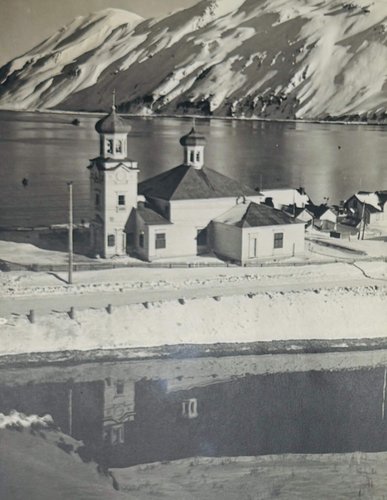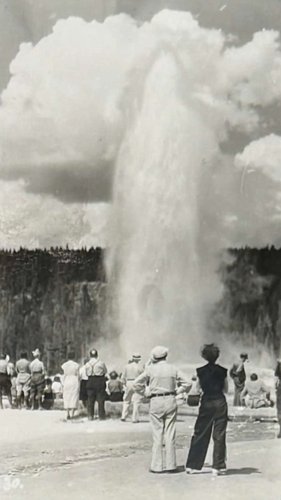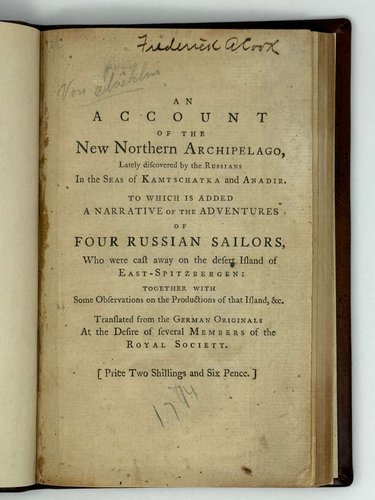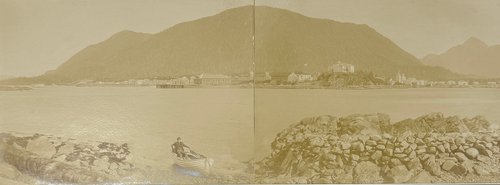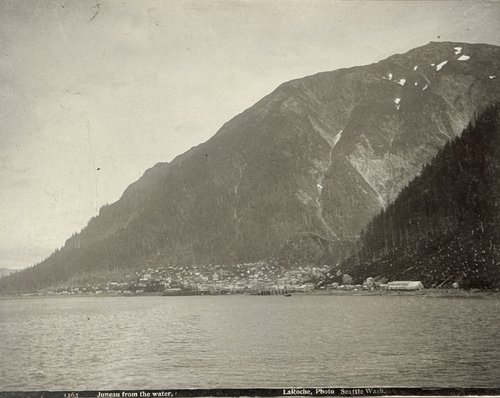









































#PA48
Ca. 1940-1944
Oblong Folio album (ca. 29x38,5 cm). 16 black card album leaves. With 177 mounted and three loosely inserted gelatin silver photos. The mounted photos include 27 larger images from ca. 12,5x17,5 cm (5 x 6 ¾ in) to ca. 10x12,5 cm (4x5 in), and 150 smaller images from ca. 7,5x12 cm (3 x 4 ¾) to ca. 6x6 cm (2 ½ x 2 ½ in). Over ninety photos with period white ink captions on the mounts; over forty with period blue ink captions on verso. Compiler’s white ink note on the inner side of the front cover. With three loosely inserted gelatin silver panoramas ca. 11x26 cm (4 ¼ x 10 ¼ in), one photo captioned in negative. Period brown cloth album fastened with a string; front board with a blind-stamped ornament. a couple of photos with minor creases, but overall a very good album of strong interesting photos.
Historically significant collection of original photos of Dutch Harbor – a settlement on the Umaknak Island in the Unalaska Bay (Fox Islands), where the US naval base was constructed in September 1940 – January 1941, and of Sand Point and Unga villages on the Shumagin Islands off the Alaska Peninsula. The photos were taken and collected by a local resident – likely, a civilian employee of the Dutch Harbor naval base. Over a hundred photos show Dutch Harbor in ca. 1940-1941, with a series of interesting pictures of the settlement and Captains Bay “before the air base was started,” including aerial and close-up street views with “old Russian hotel” and “steam cloud from volcano in background.” The other photos show the naval base under construction, “start of the air base,” the completed naval radio station, the “site of part of Dutch Harbor Air Base,” the settlement with “Marine barracks in back,” “sand spit in front of D.H.,” Amaknak Island and “sheep ranch on Amaknak Island,” “Dutch Harbor restroom, note the wind bracing,” “construction of marine barracks at Dutch Harbor,” completed barracks (the photo is dated January 15, 1941), “barracks and B.O.Q., Standard Oil tanks in front,” &c. There are also images of the Dutch Harbor with naval ships USS “Spica” USS “Charleston” and Alaska Steamship Co.’s ships “Cordova” and “Tanana.”
Eleven photos depict the story of SS “Northwestern,” which was grounded on the beach in Dutch Harbor during the storm in December 1940 and was aftewards turned into a barracks for civilian construction workers at the airbase. The photos show the ship before the storm, “during the storm” and “taking a beating on the beach,” “taking the marines off after the storm,” the damage in the ship’s stern (“notice how the anchor chain ripped the steel plates”) and “Northwestern ”at its “final berth.” Over a dozen photos document the “warehouse fire at Dutch Harbor, 12-16-40,” showing the flames, “some of the damage by explosion when dynamite went off,” the burned building of the “Alaska Commercial Company,” “D.H. office after the explosion,” damaged post office and “Old Russian Hotel” with broken windows. The album also contains excellent views of Unalaska town and harbour taken from different positions, “Mt. Makushin – an active volcano,” Mt. Ballyhoo, Captains Bay, Holy Ascension Russian Orthodox church, a “native dwelling at Unalaska,” “Indian Service Hospital at Unalaska,” a scene of “blasting rock from channel in front of Unalaska, Dec. 1940,” &c.
Fifty photos at rear and several images throughout the album show the villages of Sand Point & Unga on the neighbouring Popof and Unga Islands of the Shumagin group, south of the Alaska Peninsula. The photos were apparently taken in ca. 1942-1944 during the compiler’s work there and depict both villages in great detail, showing local cod cannery and saltery, general stores, “Russian church” (St. Nicholas chapel) in Sand Point, U.S. Marshall’s house & office, jail, school house, liquor store, “blacksmith shop” in Unga, &c. Three large gelatin silver panoramas also show Unga village and harbour; one photo is captioned “Unga, Alaska” in negative. Unga became a ghost town when the last Aleut family left for Sand Point in 1969.
Some of the captions to the photos of Sand Point and Unga: “Looking south from spit at cannery at Sand Point,” “Sand Point spit in front below,” “Equipment at Sand Point cannery,” “Cannery as Sand Point, burned Dec. 1942,” “Machine shop & bunk house, Sand Point cannery, note shot on side hill. Excavating for new water tank, March 1942,” “Cannery in foreground, Sand Point village in back,” “Sand Point, Alaska, March 1942,” “General and only store in Sand Point,” “Store Bldg. used as warehouse,” “Cannery at Sand Point,” “Russian church & parsonage, Sand Point,” “Unga Island from Sand Point,” “Fresh water lake back of cannery, Sand Point,” “U.S. Marshall’s house & office, jail in rear, Unga, Alaska, June 1944,” “School house, Unga, Alaska,” “Unga, Alaska, looking south,” “Pool Hall, Unga,” “General store from rear,” “Casey’s general store, small building is liquor store, Unga,” “Dock at Unga,” “Warehouse, oil storage & blacksmith shop, Unga,” “Unpainted bldg cod saltery, bldg with Unga sign, Picture show white house, Casey’s residence, taken standing on dock.”
The photos of other places in Alaska include three views of the partly submerged wreck of USS “Kvichak,” after it grounded on reefs south of Ketchikan on January 17, 1941. There are also several views of Seward and environs, including a photo of “the Brown Bear, Alaska Game Commission boat at Seward,” pictures of the Alaskan Peninsula, the crater of Mt. Aniakchak, &c.
The album is supplemented by three newspaper clippings, dated 1940-1942 (all possibly from “The Seattle Times”), reporting about the events in Dutch Harbour – the wreck of steamer “Northwestern” in December 1940, the fire on the naval base in 1941 and the Battle of Dutch Harbor on June 3-4, 1942. The manuscript note on the inner side of the front cover reads: “The pictures of the Aleutian Islands & pictures of Unalaska and Dutch Harbor, Alaska were either picked up or taken by me on my trip from Sitka to Dutch Harbor. Left Sitka on January 1st 1941 and returned March 29th, 1941.” Overall an important original visual source on the history of Dutch Harbour settlement, naval base, and Sand Point and Unga villages during WW2.










































